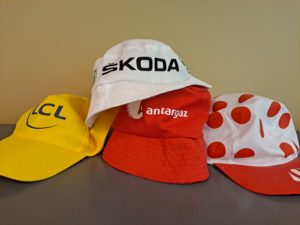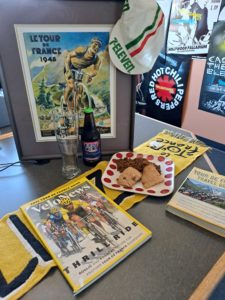Feed The Resistance: It’s Tour de France Time! A Smoky, Warm, French Lentil Salad is paired with Karben4’s “Night Call”
My wife and I are BIG fans of bicycle racing. Our obsession has taken us to France several times for le Tour de France, and when we can’t be there, you can find us on the couch, watching the race on TV (we go out for a ride after the day’s race). During our visits to France, in addition to the race, we have enjoyed the food and drink of the country – even taken a private cooking class in a chef’s home in Lyon. One dish that we have always enjoyed is the French Lentil Salad. Over the years we have found recipes for several different variations on this salad – and this one is definitely our favorite! We always add a good sausage to the basic recipe, and for the first time, this time we served it with salmon. YUM!
Dee wanted to play off of the smokiness of the salad, so she paired it with her favorite Smoked Porter – “Night Call” from Karben4!
le Tour de France
I promised Dee that I would post some tips on how to watch le Tour de France – since cycling is a sport that is not like most spectator sports that we watch here in the U.S.
Let’s start with the fact that it’s a race that takes place over 3 weeks. There is a separate race each each day – each of those races is called a “stage.” The riders have 2 rest days during the 3 weeks – they fall on the second and third Mondays of the race. Other that that – they are racing every day, and they are NOT short days in the saddle – most days are somewhere between 150 and 200k (roughly 90 – 120 miles)!
I’m often asked about the route. The route changes every year – usually making a rough loop around France. During odd years that loop goes clock-wise, during even years its counter-clockwise. The only part of the race that is the same from year to year is the finish in Paris.
This one’s gonna seem really strange – Bicycle racing is a TEAM SPORT, with an INDIVIDUAL WINNER. The guy that you see on the podium in Paris every year gets all the glory, but he could not do it without the support of his team. The team does a lot of the work during each of the stages – leading pace-lines and keeping that team-leader out of the wind…keeping their guy out of dangerous situations…and controlling the overall pace of the race when another team tries to move their guy to the front. The team does a lot of the grunt-work while the team-leader gets the glory.
There are several races going on within the main race…
Stage wins are important. Each day’s race has a winner – that person may or may not be the overall leader of the race (well, the winner of stage one IS the overall leader – at least for that one day).
Yellow Jersey – this is the BIG ONE! This is what everyone watches for on TV – the overall leader of the race. This is the guy with the lowest overall time, when you add up all of the stages.
Polka-Dot Jersey – this is for the best climber of the race. When the race heads into the mountains, there are “King of the Mountain” points that riders can collect by being one of the first riders up a mountain climb. The rider with the most “King of the Mountain” points wears the polka-dot jersey.
Green Jersey – this one is for the “points leader.” Within each stage of the race there are sprinting points awarded. The riders sprint to specific spots along the route – the first riders to each of those spots (including the finish line) are awarded points. The guy with the most points wears the Green Jersey.
White Jersey – this is for the best young rider. Young rider is defined as under 25 years old. The white jersey is worn by the guy under the age of 25 with the lowest overall cumulative time.
So what happens if you are champion in more than one of those categories? You wear the higher jersey – if you are points and yellow jersey leader – you wear the yellow jersey and the green jersey will be worn by the number 2 guy in that competition.
U.S. television coverage of le Tour is excellent! In France they basically put a camera on the race, and you are expected to know what’s going on. U.S. coverage gives you much more information -at any given time you can see where in the race each of those jersey wearers currently is, how far out in front the race leaders are, how far back each chase group is, etc. Plus, Phil Liggett and Bob Roll are two of the best sports commentators alive today. They both have amazing stories to tell and know the sport inside and out – it’s kinda like listening to Bob Uecker calling a Brewers game!







